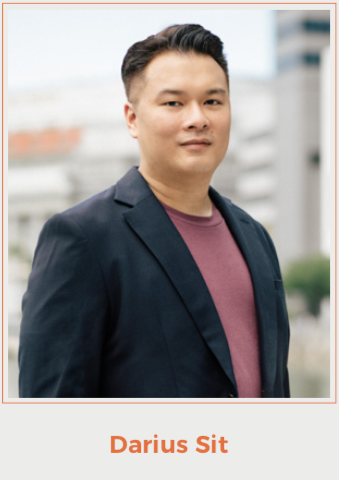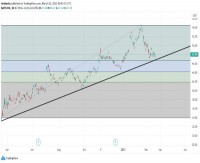|

Darius is an early pioneer in the Singapore crypto-trading scene. Fresh out of the National University of Singapore Darius joined Dymon Asia Capital, Asia's largest macro hedge fund. There he learned intricacies of macro trading and was exposed to the entire spectrum of financial derivatives including financial options. Darius' foray into crypto-trading started off in 2016 with simple arbitrage opportunities, arbitraging Bitcoin prices between different countries. What started off as a hobby, quickly became a serious business opportunity when he saw the potential of crypto-assets. Matthias Knab: Do you think cryptocurrencies will still be around in the next 5 years? Darius Sit: Yes, but it may not exist exactly in its current form, but definitely yes. Bitcoin was envisioned to be a currency with limited supply to be used as a store of value. It is presently fulfilling the store of value function, but as a currency used for the exchange of goods and services, it seems to have fallen short for now. That said, there are many ongoing projects within the crypto ecosystem that are trying to correct this, or in some way shape or form, trying to work around this issue. Matthias Knab: Will I lose my coins to hackers? Darius Sit: Such worries, or complaints by those that reject crypto assets are simply excuses for resisting the change. Many banks and individuals have been robbed, since the creation of fiat currency, but you don’t see people complaining about the dangers of holding money in their wallets thus rejecting fiat. While I’ll admit that it is an over-simplification, my point is that with sufficient profit motive, the market will find the solutions, and they have. The increased adoption of crypto currencies globally has driven up its value, making many early adopters very wealthy. This wealth creation and the increased market cap of crypto assets has translated into demand for services to keep crypto assets safe. Judging by the increase in institutional offering and the overall improvement of quality of these offerings, I believe the cyber- security in both custodians and exchanges have been greatly strengthened since those days where people’s coins could be stolen, or held at ransom by hackers. Unfortunately many late adopters still remember many of those stories about coins being hacked, not realising the technology has improved significantly over the last five years. That said, any cyber-security expert will tell you that the weakest link in cyber security are humans, so as people start to hold more digital assets, they will likely become more savvy in terms of good cyber- security hygiene. I’m optimistic that these concerns will fade away quickly, if not already. Matthias Knab: Bitcoin has appreciated roughly 8.5x in 2020, and then halved again in 2021. But this is nothing new – this cycle has come to be known as “crypto winter.” In October and November 2013, bitcoin rose 10-fold and then fell 87% through January 2016. In 2017, the price rose nearly 20 times, and then fell 84% over the next year. It didn’t recover its previous high until late 2020. Still, Bitcoin still seems to be some fundamental attraction for different types of investors, but they need to be able to stomach this type of volatility. What are your thoughts here? Darius Sit: Such volatility is indeed a big risk, but it also presents great opportunities. This is precisely why investors should opt for an alpha strategy as opposed to the passive strategy. Bitcoin’s price action as you described above presents a lot of alpha opportunities, the key is a robust risk management framework. I believe astute institutional investors can invest in hedge funds that deal exclusively in crypto assets. Much of the talent pool that has crossed over to the asset management side of crypto trading have come from either financial institutions, or hedge funds. These individuals happened to also be early adopters of the asset. They saw the opportunities in this asset class, figured out a way to monetize it, and never looked back. Essentially, this is our story, and it isn’t a unique one. Like any other asset, there are idiosyncrasies and nuances within the crypto space, early adopters still have a significant edge. This edge comes from being part of the crypto ecosystem early on. It is a tight knit community where folks trade market insights and deals very selectively. It is a bond forged through surviving the “crypto-winter”. All the early adopters had to suffer through the period after Bitcoin crashed from $20,000 to $4,000. In our case, we focused on what we knew, which is market structure. We were one of the earliest players in the crypto derivatives market and continue to be a significant player in the space. Early on we focused on capitalizing on the inefficiencies in the space and continue to do so. Since the crypto markets have deepened significantly over the last 15 months, we now feel that the time is right to also take on third party capital. Previously, we weren’t comfortable. I don’t believe crypto currencies will never replace fiat. I believe over time the two will co-exist. In my mind, I see crypto currencies co-existing with fiat, as a check on ill-disciplined central banks. For us, we don’t just trade crypto-currencies in isolation, but also look at all the macro themes globally and see how it may potentially impact crypto assets. Not too different from macro investing, which is why it isn’t too surprising that someone like Paul Tudor Jones would come out to speak about it. Matthias Knab: Will financial regulators or central banks step in to ban cryptocurrencies? Darius Sit: I think it would be almost impossible to ban crypto currencies altogether, unless every country in the world took a stance to outlaw it. That said, I believe we are well past the point of crypto currencies from being banned. As mentioned previously, I see crypto currencies co-existing with fiat and would probably serve to be a check on central banks from being too eager to increase money supply in an unfettered manner. One of the main reasons Bitcoin has had such strong adoption is because all the major economies in the world are engaged in extremely easy monetary policy. We are seeing zero, or near zero interest rates in most major economies. We are also seeing the resumption of quantitative easing. Now we are even seeing “helicopter money” by way of governments directly giving cash, or cash rebates to citizens to help them manage through this pandemic. It is clear to investors, as well as the layman, that there is no scarcity in fiat and there will be a price to pay down the road. This is why the adoption of crypto currencies has been so fervent in recent times. Barring that “government’s of the world unite” moment, the crypto currency ecosystem would simply gravitate to a jurisdiction that is benign to it. Matthias Knab: There has been a lot of talk in media about institutions buying crypto - you are on one of the largest crypto brokers, can you confirm this? Darius Sit: I think it depends how you define institutions in this case. A lot of the headlines recently were about corporates buying - Tesla, MicroStrategy and a few other US names have been buying bitcoin. We also saw hedge fund and “old hands” such as Paul Tudor Jones who said he was buying, along with a growing number of hedge funds. In Asia, where we are located, we mostly see high net worth and family offices expressing interest in cryptocurrencies while the corporates have not participated much yet. I think it is because there is still lack of clarity on taxation and on accounting. Matthias Knab: Apart from bitcoin, what other coins could investors look at? Darius Sit: For us it’s really about coins that have specific market structures – a volatility curve and basically an options market and a rates market. Right now, the only coins that have this market structure are bitcoin and Ethereum. To some extent, bitcoin cash. The rest of the coins don’t really have options or rates markets yet. But that’s our view of what could represent institutional grade coins. If you look at market cap of some of these alternative coins, you could argue that there are a lot of “blue chip” coins as well – coins that have either been around for a long time or coins that have in the recent times had a lot of attention and a growing market cap making them blue chip, especially some within the DeFi space. Matthias Knab: Why is that so important to have a rates market or options market? Darius Sit: Well, for one, you have much deeper liquidity and more institutional players in it who are familiar with traditional market structures and therefore, understand and are investing or trading these coins in sophisticated ways rather than just pure speculation. Matthias Knab: Recent reports said that more hedge fund giants like Millennium, Matrix, Point72 would start trading crypto. How do you see the creation of such crypto funds changing the dynamics? What will be the effects? Darius Sit: We have actually spoken to some of these guys on your list as they have been exploring trading in crypto; I actually think this would be interesting. From the conversations that we’ve had, they are able to enter the crypto market but only certain segments. For example, they would be able to trade CME futures or they would be able to trade on regulated markets like Coinbase, or regulated exchanges. But there are many parts of the crypto market that they will not be able to have access to, such as non-regulated exchanges. I think this would be difficult for them given compliance. This has been part of the discussion, how do they tap these markets when a lot of the liquidity pools are not regulated. If they default on you, you have no recourse and you don’t know who to sue because in most cases there’s no domicile and no jurisdiction behind them. Therefore, it becomes difficult for these big institutional funds to participate. But irrespective of that, if more professional investors such as hedge funds come in and participate in certain segments of the market, I think it would actually create additional dislocation simply because we would witness this heavy participation in certain segments from institutional players but less so in other segments. We actually see this already in the current market already, right? The forward curve on the CME futures and the forward curve on the non-regulated exchange futures are very different and very arbitrage-able because one has the participation of the institutions and one does not. This for me shows a potential for added dislocation. Apart from funds we’ve also been talking to banks. Goldman Sachs originally announced that they want to enter the market but they won’t touch the physical, they will only be trading a cash-settled non-deliverable forward (NDF). Again, we see an opportunity here because the same way that Asian currencies used to have a spot versus NDF, right now you have banks that will be trading a different curve on the NDF forward market versus guys who can trade in spot market. You end up having new products, new curves, new dislocations that would be tradeable and arbitrage-able. Matthias Knab: We spoke about the interest of the blue chip, mega hedge funds to trade crypto, and then on the other side are their much smaller brethren and even dedicated crypto hedge funds. Are these type of funds also trading on regulated exchanges only or do you see them venturing into physical and unregulated markets? Darius Sit: Many of them will have access to both markets, so they would trade the spot market and the non-regulated markets as well and thus are able to trade the full spectrum. Depending on their set up and the nature of their end clients, they probably will not face the kind of difficulty like the institutional hedge funds, but really the kind of access for each player also varies quite a lot depending on what they are focused on. Just to add, these smaller actors are to a great extent existing players or crypto natives, so they won’t cause any additional dislocation. They will have dual access to the whole spectrum of products. Matthias Knab: But there is probably a reason why the institutional funds shy away from unregulated markets, and in fact you already mentioned a few. Investors in those funds probably take on additional levels of risks, like counterparty risk. What types of risks should the end investor be aware of and analyze when doing a due diligence on these smaller funds who play all markets? Darius Sit: You are right, counterparty risk needs to be analyzed when a fund trades on non-regulated exchanges. Some of those are involved in practices that would be very frowned upon in institutional markets, so there is not just counterpart risk, but also trading risk on these exchanges. We have also seen exchanges come and go either from hacking risk or fraud. Within the spectrum of non-regulated markets, there are good exchanges and bad exchanges as well. So, as you suggest, it is a good idea when you look at a fund that’s trading cryptocurrencies to look through which venue and market are traded and what the risks are, because having the right counterparties and having the right relationships with counterparties is very important. How do we as specialists focusing on derivatives and specifically options on cryptocurrencies deal with this? We have made it a point to invest in one of the biggest option trading venues in the early days. Our SPV is in fact one of the largest shareholders in that exchange. As shareholders, we are able to mitigate some of the counterparty risk and some of the trading risk by ensuring that proper measures are set in place and that we have trading agreements that are transparent and favorable to us and our investors. Matthias Knab: Apart from trading cryptocurrencies it was also reported that Millennium, Matrix, Point72, and probably others would also be starting DeFi or decentralized finance funds. There are already a number of VC firms dedicated to DeFi as well. Do you have any recommendations for investors who are interested in getting exposure to DeFi? Darius Sit: Well, DeFi is a very big topic of interest of course. It claims to be the next iteration how finance and investments operates within a more democratic and decentralized framework. But I would say it’s very early stages. DeFi only started to boom the second half of 2020 and there are still a lot teething issues. You know, as you can see every other week some form of exploitation of a DeFi protocol becomes public, and so I would recommend caution. By definition, there is no intermediary in DeFi protocols, and so if anything happens, there is no recourse. What does this now mean? Well, if you are going to use a DeFi solution you should look at the code. You need to know that code and you also need to know the team members of the protocols which are often anonymous. As you can imagine, DeFi in the end comes with big question marks, not just for many investors but for regulators as well who, at least at this stage, don’t know how to regulate DeFi and as everyone else are not sure of what the risks are. New DeFi protocols are coming up every day, and so how do you separate the good from the bad? How do you identify which are safe and which are not? I think this is a very tricky question given that DeFi is such a new space even within crypto. I would say the approach would probably be to err on the safe side by sticking with the blue-chip ones, meaning the DeFi protocols that have been around for a long time and more well-known. | ||||
|
Horizons: Family Office & Investor Magazine
Darius Sit: Cryptocurrencies and the relevance of market structure |
|





 RSS
RSS









